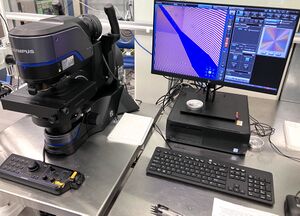Laser Scanning Confocal M-scope (Olympus LEXT): Difference between revisions
Jump to navigation
Jump to search
Content deleted Content added
initial page |
|||
| Line 1: | Line 1: | ||
{{tool|{{PAGENAME}} |
{{tool|{{PAGENAME}} |
||
|picture= |
|picture=OlympusDSX1000.jpg |
||
|type = Inspection, Test and Characterization |
|type = Inspection, Test and Characterization |
||
|super= Tony Bosch |
|super= Tony Bosch |
||
|phone=(805)839-3918x217 |
|||
|location=Bay 4 |
|location=Bay 4 |
||
| ⚫ | |||
|email=bosch@ece.ucsb.edu |
|||
| ⚫ | |||
|manufacturer = [http://www.olympus-ims.com/en/metrology/ols4000/ Olympus] |
|manufacturer = [http://www.olympus-ims.com/en/metrology/ols4000/ Olympus] |
||
|materials = |
|materials = |
||
|toolid=3 |
|||
}} |
}} |
||
= About = |
= About = |
||
The Olympus DSX1000... |
|||
The LEXT OLS4000 3D Laser Measuring Microscope is designed for nanometer level imaging, 3D measurement and roughness measurement. Magnification ranges from 108x - 17,280x satisfy the needs of today's researchers. For a complete description of the tool and its capabilities, please see the above link to the manufacturer’s website. |
|||
=== Technique & Capabilities === |
=== Technique & Capabilities === |
||
Digital only (view through computer) |
|||
[[File:Olypmus LEXT Example Profile Measurement.png|alt=Measurement of 5µm wide posts|thumb|205x205px|Example Height/Profile Measurement (click to enlarge)]] |
|||
Objectives: 5x, 50x |
|||
The LEXT allows you to take height measurements of features too small to reach with a physical Stylus needle, in a non-contact mode that is much faster than engaging an AFM tip. In addition, very large aspect-ratios can be measured - for example, 1mm depth x 50µm width. Confocal microscopy ensures that only surfaces that are in-focus will return a signal to the microscope detector. The LEXT sweeps the focus motor and captures a 2D scan of your sample at each focus step, taken with a blue laser (405 nm). After the scan, the height of each surface is calculated by the focus step which produced the highest laser intensity, and this is constructed into a 3D image by the OLS software. |
|||
Imaging Modes: Bright, Dark Field, DIC (Nomarski), |
|||
Top Reflected Illumination (Episcopic) |
|||
Because this is an optical method, films that are optically transparent to blue light and/or have transparent sloping sidewalls can produce non-physical measurements due to optical interference on the sample. In addition, features on the order of the laser wavelength can produce unreliable/non-physical data - for example, the data near (within ~500 nm) very steep slopes, or features ≤ 1.0 µm wide may not be reliable. |
|||
Camera Capture: |
|||
Surfaces that are opaque to the laser wavelength work best, although measurements on rectangular transparent edges do work relatively well. Edges of steps where light does not reflect in an ideal manner often produce non-physical features, typically manifesting as trenches/spikes right next to the sidewall. |
|||
Technically the height-resolution is specified as 10 nm (the height resolution of the focus motor), but in practice, noise and optical uncertainties worsen this spec. |
|||
== Operating Procedures == |
== Operating Procedures == |
||
[[Olympus |
[[Olympus DSX1000 - Quick Start|Olympus DSX1000 Quick Start.pdf]] |
||
=== Offline software === |
=== Offline software === |
||
[ |
[www.google.com Olympus Stream Desktop Offline Software (TEMP)] |
||
Revision as of 18:25, 9 April 2021
|
About
The Olympus DSX1000...
Technique & Capabilities
Digital only (view through computer) Objectives: 5x, 50x Imaging Modes: Bright, Dark Field, DIC (Nomarski), Top Reflected Illumination (Episcopic) Camera Capture:
Operating Procedures
Olympus DSX1000 Quick Start.pdf
Offline software
[www.google.com Olympus Stream Desktop Offline Software (TEMP)]
